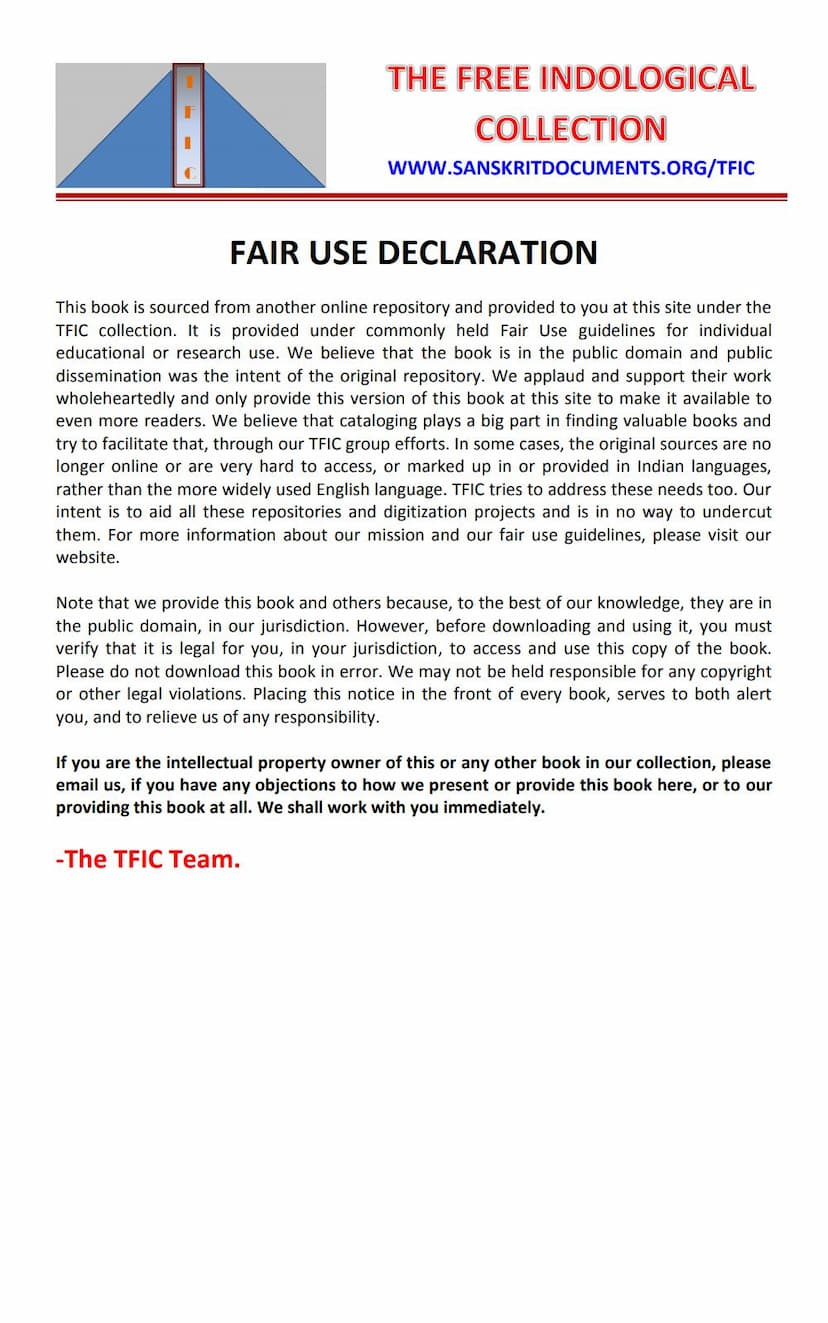Karmkanda Kramavali
Added to library: September 2, 2025

Summary
This document is a scanned copy of the Karmakanda Kramavali by Sri Somashambhu, critically edited by Pandit Jagaddhar Zadoo. It was published in 1947 AD as part of "The Kashmir Series of Texts & Studies," No. LXXIII.
The book is a comprehensive manual of Shaivaistic ritualistic practices. It outlines in detail the procedures for various daily observances, consecrations, and ceremonies performed by orthodox Hindus who strictly adhere to the Tantric system.
Key aspects covered in the Karmakanda Kramavali include:
-
Daily Rituals:
- Snana (Bathing): Detailed descriptions of various types of baths, including Mala Snana (using earth for cleansing), Vidhi Snana (obligatory bath), and others like Varuna (water bath), Agneya (ash bath), Mahendra (rain and sunshine), Pavana (wind), Mantra (with mantras), and Manasa (mental bath). It specifies purification rituals based on contact with impure substances or beings.
- Tarpana (Water Offerings): Procedures for offering water to deities, sages, ancestors, and various cosmic entities.
- Bhojana (Eating): Rules regarding dining etiquette, seating arrangements based on caste, and the types of vessels to be used. It also includes injunctions on food quantity and water consumption.
- Sandhya (Twilight Rituals): The text details the performance of morning, noon, and evening Sandhya rituals, including meditation and mantra recitation.
-
Auspicious and Purification Rites:
- Diksha (Consecration/Initiation): Various types of Diksha are explained, including Samaya Diksha and Nirvana Diksha, along with the roles and qualifications of the preceptor (Acharya).
- Pratishtha (Consecration of Idols and Structures): Procedures for consecrating temples, shrines, and public utility works.
- Homa Karma (Fire Sacrifice): Detailed instructions for performing various fire sacrifices.
- Bali Vidhana (Offerings to Deities/Spirits): Rituals for offering Bali.
-
Rites for the Deceased and Expiation:
- Antyeshti (Funeral Rites): The rituals performed after a person's death.
- Shraddha (Rites for Ancestors): Ceremonies performed for the departed ancestors.
- Prayashchitta (Expiation): Methods for atonement and purification for various sins and transgressions.
-
Specific Deities and Practices:
- Worship of Surya (Sun God): Detailed procedures for the Anga-archana (worship of different parts) of Surya, including the planets and the Sun's associates.
- Worship of Guardians: Rituals for worshipping door guardians and other protective deities.
- Vastu Puja (Worship of Vastu Purusha): Consecration of the site before construction.
- Worship of Various Deities and Forms: Including Ganesh, Saraswati, Lakshmi, Nandi, Mahakala, and others.
- Pavitra Avasthana (Installation of Sacred Threads): Rituals for creating and installing sacred threads.
- Damanaka Puja: Worship of the Damanaka plant, associated with Shiva.
- Kapila Puja: Worship of the divine cow Kapila.
-
Details on Ritualistic Elements:
- Mandala Puja: Worship within ritualistic diagrams.
- Kumbha Sthapana: Installation of sacred<bos> pots.
- Murti Nyasa: Installation of deity images.
- Lingam Puja: Detailed worship of the Shiva Lingam.
- Kunda Sthapana: Construction and consecration of sacrificial pits.
The text also provides a colophon indicating the author's lineage and the approximate date of composition as Anno Vikrami 1130 (corresponding to 1073 AD), suggesting the author might not have been from Kashmir despite the publication series. The author, Somashambhu, is presented as a disciple in a lineage tracing back to Ishana.
The index (Vishayanukramanika) at the beginning of the book meticulously lists all the topics covered, providing a comprehensive overview of the extensive ritualistic knowledge contained within. The book is written in Sanskrit with the content described in English in the foreword.